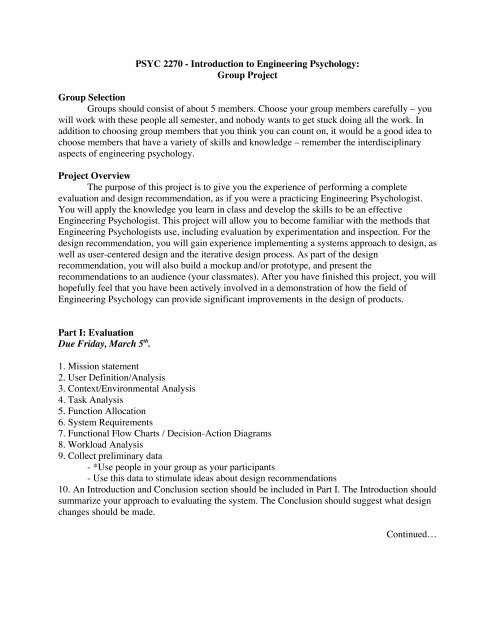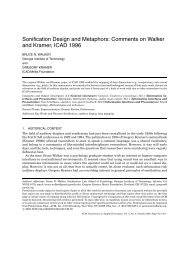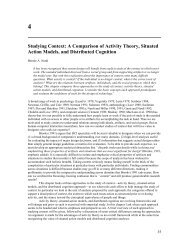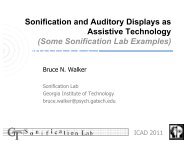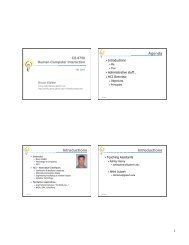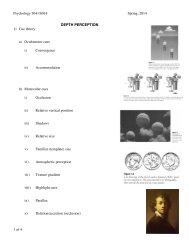PSYC 2270 - Introduction to Engineering Psychology: Group Project ...
PSYC 2270 - Introduction to Engineering Psychology: Group Project ...
PSYC 2270 - Introduction to Engineering Psychology: Group Project ...
Create successful ePaper yourself
Turn your PDF publications into a flip-book with our unique Google optimized e-Paper software.
<strong>PSYC</strong> <strong>2270</strong> - <strong>Introduction</strong> <strong>to</strong> <strong>Engineering</strong> <strong>Psychology</strong>:<br />
<strong>Group</strong> <strong>Project</strong><br />
<strong>Group</strong> Selection<br />
<strong>Group</strong>s should consist of about 5 members. Choose your group members carefully – you<br />
will work with these people all semester, and nobody wants <strong>to</strong> get stuck doing all the work. In<br />
addition <strong>to</strong> choosing group members that you think you can count on, it would be a good idea <strong>to</strong><br />
choose members that have a variety of skills and knowledge – remember the interdisciplinary<br />
aspects of engineering psychology.<br />
<strong>Project</strong> Overview<br />
The purpose of this project is <strong>to</strong> give you the experience of performing a complete<br />
evaluation and design recommendation, as if you were a practicing <strong>Engineering</strong> Psychologist.<br />
You will apply the knowledge you learn in class and develop the skills <strong>to</strong> be an effective<br />
<strong>Engineering</strong> Psychologist. This project will allow you <strong>to</strong> become familiar with the methods that<br />
<strong>Engineering</strong> Psychologists use, including evaluation by experimentation and inspection. For the<br />
design recommendation, you will gain experience implementing a systems approach <strong>to</strong> design, as<br />
well as user-centered design and the iterative design process. As part of the design<br />
recommendation, you will also build a mockup and/or pro<strong>to</strong>type, and present the<br />
recommendations <strong>to</strong> an audience (your classmates). After you have finished this project, you will<br />
hopefully feel that you have been actively involved in a demonstration of how the field of<br />
<strong>Engineering</strong> <strong>Psychology</strong> can provide significant improvements in the design of products.<br />
Part I: Evaluation<br />
Due Friday, March 5 th .<br />
1. Mission statement<br />
2. User Definition/Analysis<br />
3. Context/Environmental Analysis<br />
4. Task Analysis<br />
5. Function Allocation<br />
6. System Requirements<br />
7. Functional Flow Charts / Decision-Action Diagrams<br />
8. Workload Analysis<br />
9. Collect preliminary data<br />
- *Use people in your group as your participants<br />
- Use this data <strong>to</strong> stimulate ideas about design recommendations<br />
10. An <strong>Introduction</strong> and Conclusion section should be included in Part I. The <strong>Introduction</strong> should<br />
summarize your approach <strong>to</strong> evaluating the system. The Conclusion should suggest what design<br />
changes should be made.<br />
Continued…
Part II: Design Recommendation<br />
Due April 16th<br />
1. Your new design may or may not necessitate an important change in any of the aspects<br />
considered in Part I Evaluation, such as the task preformed, users involved, or how the functions<br />
are allocated. If your new design does necessitate these types of changes, then you should redo<br />
the relevant steps in Part I for the new design, before you implement the new design. For<br />
example, if you implement a new workflow, then do a new workflow diagram <strong>to</strong> document the<br />
changes.<br />
2. Evaluations/recommendations for improvement of the following:<br />
- Displays<br />
- Controls<br />
- Workspace layout<br />
- Anthropometry<br />
3. Mockup<br />
4. Collect data on redesigned system<br />
- *Use people outside of your group but within this class as your participants.<br />
- Use this data <strong>to</strong> assess the effectiveness of your redesign.<br />
5. Answer these questions:<br />
1) Is there a need for additional functions<br />
2) Is there a need <strong>to</strong> reduce functions<br />
a. If yes <strong>to</strong> 1 or 2, generate additional FFCs or DADs<br />
3) Does the design meet ADA requirements<br />
a. Displays/controls/workspace/anthropometry<br />
6. An <strong>Introduction</strong> and Conclusion should also be included in Part II. The <strong>Introduction</strong> should<br />
summarize the reasoning for design recommendations suggested from Part I and their<br />
implementation. The Conclusion should summarize all the design changes and procedures that<br />
you completed in Part II, as well what the data collected in Part II say about your new design.<br />
7. In-class presentation<br />
- Approximately 15 minute talk, presented during last week of semester.


